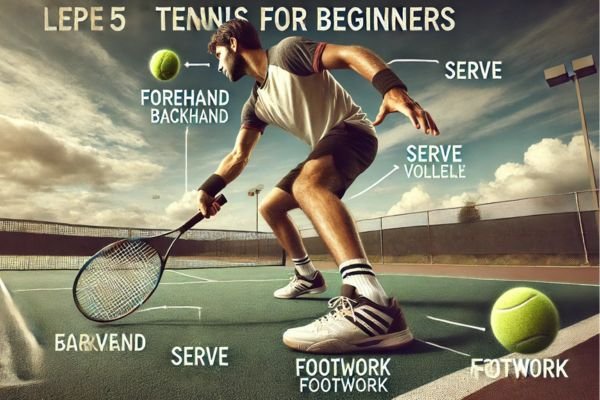Tennis is an exciting and dynamic sport that combines skill, strategy, and physical endurance. For beginners, it may seem daunting at first, but mastering a few basic techniques can make a big difference in how quickly you improve. Whether you’re looking to play casually or take the sport more seriously, understanding the fundamental techniques will put you on the right track. In this article, we will detail the 5 key essential tennis techniques that every beginner should focus on.
1. Mastering the Forehand
The forehand is one of the most important strokes in tennis. It is often the first technique a beginner learns and forms the foundation of many of their offensive plays. A well-executed forehand allows you to hit the ball with power and precision.
Important tips for a strong forehand:
-
Grip: Start by holding the racket with a basic eastern grip. This provides control and consistency.
-
Positioning: Position your body sideways to the net, with your non-dominant shoulder facing the opponent.
-
Swing: As the ball approaches, rotate your hips and shoulders, and swing the racket forward in a smooth motion. Follow through after contact to generate more power and control.
2. Perfecting the Backhand
The backhand is a crucial technique, especially when you’re on the defensive side of the court. While many beginners struggle with this shot, learning both one-handed and two-handed backhand techniques will increase your versatility.
Tips to improve your backhand:
-
One-handed backhand: Hold the racket with your dominant hand, making sure your grip is firm but not too tight. Slightly rotate your body as you swing, and focus on hitting the ball with the center of the strings.
-
Two-handed backhand: Use both hands to hold the racket, with the dominant hand on top and the non-dominant hand below. This grip provides better control and power, especially for beginners.
-
Focus on consistency: Whether you’re using a one-handed or two-handed backhand, the key is to maintain a consistent swing path and ensure you follow through after hitting the ball.
3. Developing Your Serve
The serve is often referred to as the most important stroke in tennis. A strong serve gives you the opportunity to dictate the point from the start. For beginners, focusing on a solid and reliable serve is more important than trying to hit it with extreme power.
Steps for a better serve:
-
Grip: Use a continental grip for your serve. This grip will help you generate spin and accuracy.
-
Stance and Toss: Stand sideways to the baseline, with your feet shoulder-width apart. Toss the ball above your head, slightly to the right (for right-handed players) or to the left (for left-handed players).
-
Swing and Follow-through: As the ball is tossed, extend your arm upwards and swing the racket over your head, hitting the ball with the center of the strings. A high follow-through will help ensure that the ball clears the net with the proper spin.
4. Learning the Volley
The volley is a technique used when you’re near the net, where you hit the ball before it bounces. It’s a critical skill for players who want to control the net and apply pressure on their opponents. Although it can be challenging, it’s essential for a well-rounded game.
Volley tips for beginners:
-
Grip: Use the same grip as your forehand or backhand for volleys. The continental grip is most commonly used because it allows for easy adjustments.
-
Positioning: Always approach the net with your racket raised and ready. Stay low to the ground with your knees bent to prepare for quick reactions.
-
Short swing: Volleys require quick, controlled movements. Focus on short, precise swings rather than large, sweeping motions. Your racket should meet the ball at its highest point for better control.
5. Improving Footwork and Movement
While hitting great shots is important, having good footwork and movement on the court is equally essential. Tennis requires constant movement, and being able to position yourself quickly for each shot can make all the difference in your performance.
Footwork tips for beginners:
-
Stay on your toes: Avoid standing flat-footed. Always stay on the balls of your feet to remain light and ready to move in any direction.
-
Side steps: Use side-to-side movement to position yourself correctly for forehand and backhand shots. This will help you cover the court more efficiently.
-
Recovery: After hitting a shot, always return to the center of the court to be in the best position for the next shot.
Key Takeaways for Tennis Beginners
Mastering these five essential tennis techniques will provide you with a solid foundation and significantly improve your game. As you continue to practice and refine these skills, you’ll gain more confidence on the court and see progress in your performance. Remember, consistency is key in tennis. Focus on developing good habits and techniques, and over time, you’ll be able to play at a higher level.
